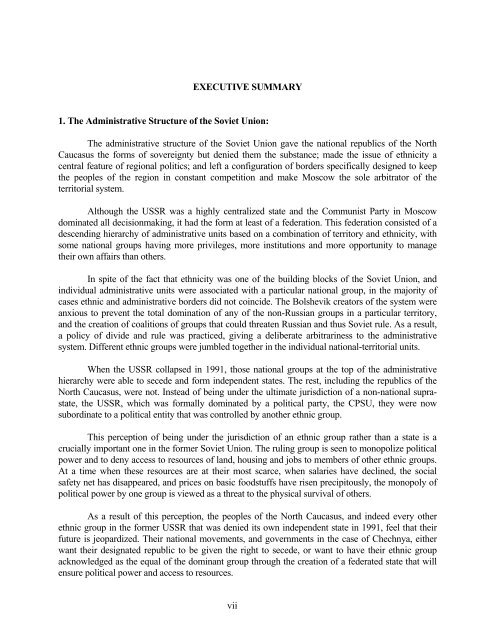RUSSIA'S TINDERBOX - Belfer Center for Science and International ...
RUSSIA'S TINDERBOX - Belfer Center for Science and International ...
RUSSIA'S TINDERBOX - Belfer Center for Science and International ...
Create successful ePaper yourself
Turn your PDF publications into a flip-book with our unique Google optimized e-Paper software.
EXECUTIVE SUMMARY<br />
1. The Administrative Structure of the Soviet Union:<br />
The administrative structure of the Soviet Union gave the national republics of the North<br />
Caucasus the <strong>for</strong>ms of sovereignty but denied them the substance; made the issue of ethnicity a<br />
central feature of regional politics; <strong>and</strong> left a configuration of borders specifically designed to keep<br />
the peoples of the region in constant competition <strong>and</strong> make Moscow the sole arbitrator of the<br />
territorial system.<br />
Although the USSR was a highly centralized state <strong>and</strong> the Communist Party in Moscow<br />
dominated all decisionmaking, it had the <strong>for</strong>m at least of a federation. This federation consisted of a<br />
descending hierarchy of administrative units based on a combination of territory <strong>and</strong> ethnicity, with<br />
some national groups having more privileges, more institutions <strong>and</strong> more opportunity to manage<br />
their own affairs than others.<br />
In spite of the fact that ethnicity was one of the building blocks of the Soviet Union, <strong>and</strong><br />
individual administrative units were associated with a particular national group, in the majority of<br />
cases ethnic <strong>and</strong> administrative borders did not coincide. The Bolshevik creators of the system were<br />
anxious to prevent the total domination of any of the non-Russian groups in a particular territory,<br />
<strong>and</strong> the creation of coalitions of groups that could threaten Russian <strong>and</strong> thus Soviet rule. As a result,<br />
a policy of divide <strong>and</strong> rule was practiced, giving a deliberate arbitrariness to the administrative<br />
system. Different ethnic groups were jumbled together in the individual national-territorial units.<br />
When the USSR collapsed in 1991, those national groups at the top of the administrative<br />
hierarchy were able to secede <strong>and</strong> <strong>for</strong>m independent states. The rest, including the republics of the<br />
North Caucasus, were not. Instead of being under the ultimate jurisdiction of a non-national suprastate,<br />
the USSR, which was <strong>for</strong>mally dominated by a political party, the CPSU, they were now<br />
subordinate to a political entity that was controlled by another ethnic group.<br />
This perception of being under the jurisdiction of an ethnic group rather than a state is a<br />
crucially important one in the <strong>for</strong>mer Soviet Union. The ruling group is seen to monopolize political<br />
power <strong>and</strong> to deny access to resources of l<strong>and</strong>, housing <strong>and</strong> jobs to members of other ethnic groups.<br />
At a time when these resources are at their most scarce, when salaries have declined, the social<br />
safety net has disappeared, <strong>and</strong> prices on basic foodstuffs have risen precipitously, the monopoly of<br />
political power by one group is viewed as a threat to the physical survival of others.<br />
As a result of this perception, the peoples of the North Caucasus, <strong>and</strong> indeed every other<br />
ethnic group in the <strong>for</strong>mer USSR that was denied its own independent state in 1991, feel that their<br />
future is jeopardized. Their national movements, <strong>and</strong> governments in the case of Chechnya, either<br />
want their designated republic to be given the right to secede, or want to have their ethnic group<br />
acknowledged as the equal of the dominant group through the creation of a federated state that will<br />
ensure political power <strong>and</strong> access to resources.<br />
vii
















